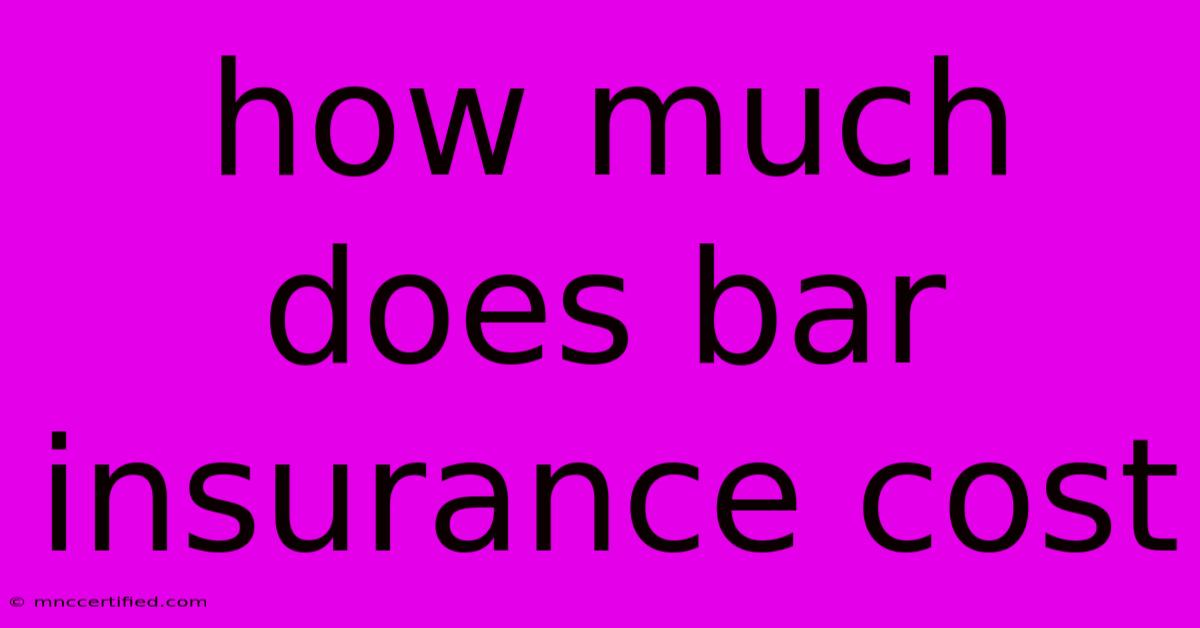How Much Does Bar Insurance Cost

Table of Contents
How Much Does Bar Insurance Cost? A Comprehensive Guide
Thinking of opening a bar or already own one? Understanding the cost of bar insurance is crucial for budgeting and protecting your business. The price isn't fixed; it varies significantly depending on several factors. This comprehensive guide breaks down the costs and helps you estimate your potential insurance premiums.
Factors Affecting Bar Insurance Costs
Several key factors influence how much you'll pay for bar insurance. Ignoring these can lead to unexpected expenses or insufficient coverage.
Type of Liquor License:
The type of liquor license you hold significantly impacts your insurance costs. A full liquor license, allowing the sale of all alcoholic beverages, will generally command higher premiums than a beer and wine license. This is because the risk associated with serving a wider range of drinks increases the likelihood of liability claims.
Location:
Your bar's location plays a crucial role. Bars in high-crime areas or areas with a history of alcohol-related incidents will typically face higher premiums. Insurers assess the risk profile of the location, including crime rates, foot traffic, and proximity to other businesses.
Size and Capacity:
Larger bars with higher capacities present a greater risk, leading to increased insurance costs. More patrons mean a higher chance of accidents, injuries, or property damage.
Claims History:
Your past claims history is a major factor. Previous claims, especially significant ones, will increase your premiums. Insurers view a history of claims as an indication of higher risk. Maintaining a clean record is crucial for keeping your costs down.
Security Measures:
Implementing robust security measures, such as security cameras, adequate lighting, and trained staff, can lower your premiums. Insurers reward proactive risk management.
Employee Count:
The number of employees you have also affects your insurance costs. More employees generally mean a higher risk of workplace accidents and potential liability claims.
Coverage Limits:
Choosing higher coverage limits will naturally increase your premiums. While higher limits offer better protection, you need to balance this with affordability. Carefully consider your risk tolerance and potential liabilities when selecting coverage amounts.
Insurance Provider:
Different insurance providers offer varying rates and coverage options. Comparing quotes from multiple insurers is essential to find the best deal that suits your needs and budget. Don't settle for the first quote you receive.
Types of Bar Insurance and Their Costs
Several types of insurance are essential for bars. Understanding each type and its cost is vital.
General Liability Insurance: This covers bodily injury or property damage caused by your business operations. Costs vary widely based on the factors mentioned above, typically ranging from $500 to $2,000+ annually.
Liquor Liability Insurance: This crucial coverage protects you against claims arising from alcohol-related incidents, such as drunk driving accidents or injuries caused by intoxicated patrons. Expect to pay $500 to $2,000+ annually, depending on your risk profile.
Property Insurance: This covers damage to your bar's building and contents due to fire, theft, or other unforeseen events. The cost depends on the size and value of your property, typically ranging from $1,000 to $10,000+ annually.
Getting the Best Bar Insurance Rates
- Shop Around: Obtain quotes from multiple insurers to compare prices and coverage options.
- Improve Security: Implement robust security measures to demonstrate your commitment to risk mitigation.
- Maintain a Clean Record: Avoid incidents and claims to keep your premiums low.
- Bundle Policies: Some insurers offer discounts for bundling multiple insurance policies.
- Negotiate: Don't hesitate to negotiate with insurers for better rates.
Conclusion: Planning for Your Bar Insurance Costs
The cost of bar insurance is not a one-size-fits-all answer. It's crucial to understand the factors influencing the price and to obtain quotes from multiple providers. By understanding your risk profile and actively managing it, you can secure appropriate coverage without breaking the bank. Remember, adequate insurance protects your business and your financial future. Don't underestimate the importance of proper coverage.

Thank you for visiting our website wich cover about How Much Does Bar Insurance Cost. We hope the information provided has been useful to you. Feel free to contact us if you have any questions or need further assistance. See you next time and dont miss to bookmark.
Featured Posts
-
Bobo And Toast At Hey Bobo Cafe
Nov 22, 2024
-
Icc Warrants Netanyahu Hamas Officials
Nov 22, 2024
-
Oura Ring Sale Pre Black Friday
Nov 22, 2024
-
Ellen De Generes Flees Trump Moves To Uk
Nov 22, 2024
-
Illinois Court Overturns Smollett Hate Crime Verdict
Nov 22, 2024